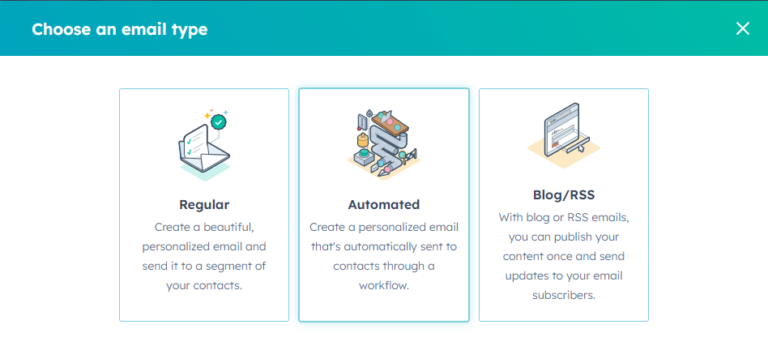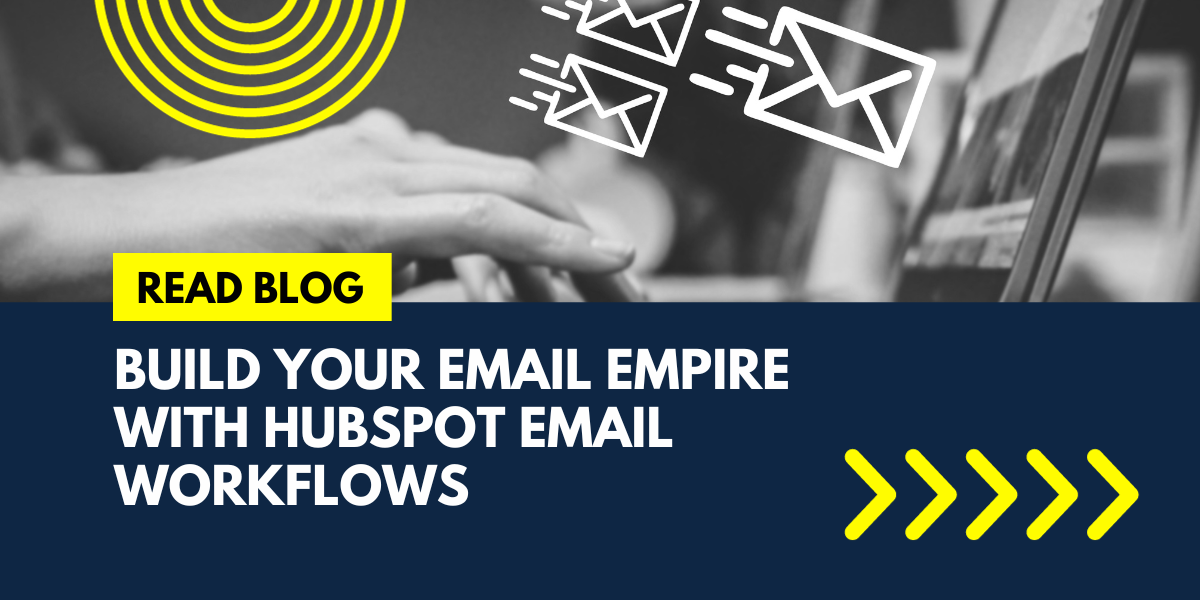The average person receives dozens of emails per day, and your HubSpot email contacts are no exception. How do you make sure that the emails you send are doing their job to nurture your contacts into customers?
Segmentation, personalization, and other methods of tailoring your email campaigns to contacts of different demographics and stages of the customer journey are all must-haves for crafting engaging emails that stand out from the dozens of emails your contacts just swipe left on and delete every day.
This is a lot to ask of your email campaigns if you’re doing everything manually—but fortunately, that doesn’t have to be the case. With HubSpot’s powerful email workflows and other automation tools, you can make crafting consistent, targeted, and engaging emails for all your marketing contacts a breeze, reap the benefits of analytics and insights for further honing your campaigns, and build a mighty content marketing empire for your products or services.
Let’s take a look at the basics of email workflows and how you can use them to send the right message to the right people at the right time – and so much more!
Understanding HubSpot’s Email Workflows
Email workflows streamline and take the more tedious aspects out of email marketing by creating automated sequences of emails triggered by specific actions or events. Email workflows aim to deliver targeted and timely content to your contacts based on their behavior, interest, and position in the buyer’s funnel to nurture leads and guide them through the customer journey.
HubSpot Automation and Email Workflows

Send a sequence of emails over a period of time without lifting a finger — once you’ve composed the email, your email automation platform does the rest. It knows when and where to send the email, how long to wait between emails and any rules you set for further customization based on the contact’s subsequent behavior. Some great use cases for email workflows include:
- Delivering downloadable assets from gated content
- Confirmation when registering for events such as webinars, meetings, or in person events
- Sending receipts when a purchase has been made
Benefits of Email Workflows
With workflows, you can engage your leads, build trust and brand loyalty through prompt communication, and drive them toward conversion through nurturing over a period of time.
Email workflows enable you to scale up your communications without scaling up your workload, build strong relationships with your audience, and improve your marketing campaigns’ conversion rates and overall success by staying top of mind.
What if you don’t use email workflows?
Skipping out on using email workflows in your marketing campaigns puts you at a great disadvantage. You’re working harder and taking longer to accomplish things with less ROI! Let’s take a look at what your team will need to take on to stay competitive without email workflow functionality:
- Doing repetitive email tasks manually means reduced efficiency and less time focusing on higher-value work.
- Time-consuming manual email processes are also inconsistent and prone to errors. They deliver a poor user experience, reflect poorly on your brand image, and can even turn customers and prospects away.
- Emails that are not personalized are less likely to engage your contacts and more likely to be deleted.
- Analyzing customer behavior, preferences and demographics manually can be and lead to missed opportunities for engagement with contacts at different stages of the buyer’s journey.
- Ineffective or nonexistent contact segmentation means your contacts get too many irrelevant emails. This decreases your chances for engagement and puts you at risk for your emails being marked as spam.
- Without email workflows, you can miss out on data insights that help you refine your current and future email campaigns.
- Automated email workflows can ensure timely responses to customers who have inquiries or problems. Without them, you could miss out on opportunities to deliver a satisfactory customer experience.
- You might miss out on chances to re-engage dormant or inactive subscribers with targeted campaigns. Don’t let your dormant subscribers become “the one that got away!”
Types of Email Workflows
Automated workflows serve many different purposes in email marketing, each with the same goal of driving higher engagement and marketing success but unique specific goals. Some common types of email workflows include:
Welcome Series
Welcome series workflows trigger when a contact joins an email list or subscribes to a newsletter. This sequence of automated emails introduces your brand, sets expectations, and delivers valuable content to make a positive first impression, engage new contacts, and take the first steps in building a solid relationship with your audience. If your business is an e-commerce model, delivering a discount code as a reward is also common to drive first conversions quickly.
 Lead Nurturing
Lead Nurturing
Lead nurturing workflows guide your leads deeper into the buyer’s funnel and help them progress toward conversion by providing educational content, addressing pain points, and offering relevant resources and different ways to reach out when they are ready to engage.
Abandoned Cart
For e-Commerce sites, the abandoned cart workflow is helpful to re-engage contacts and encourage them to complete an in-progress purchase by sending reminder emails, offering incentives, or addressing concerns about the product.
Re-Engagement
For disengaged or inactive contacts, re-engagement workflows focus on bringing them back into the buyer’s funnel by offering content or offers to reignite their interest in your brand.
Onboarding
When you’ve successfully brought a lead to the end of your buyer’s funnel and turned a marketing contact into a new customer, onboarding emails from specific team members will help guide them through the process of getting started. Emails that share instructions, tutorials, tips, or best practices help the customer make the best use of your offering right out of the gate. This is a great opportunity to drive that personal connection between the customer and your team members.
Upselling and Cross-Selling
Workflows for upselling or cross-selling opportunities target existing customers to promote additional products or services that complement those they’ve already bought. Personalized upselling or cross-selling email workflows help customers see how new products or services work well with those they’ve already obtained.
Events
Events such as webinars can trigger a series of emails to keep the date and topic of the event in mind leading up to it, as well as follow-up materials afterward. These email workflows enhance the event experience, boost attendance, and maintain engagement even after the event. A typical email sequence for an event may be:
- An invitation email to register for the event
- A thank you email for registering
- One or two reminder emails before the event to keep it top of mind
- A thank you email for attending, or if they couldn’t make it, a “Sorry you missed the event” email to keep in touch.
- A final email to share a recording or resources pertaining to the event so everyone can revisit the material on their own.
Best Practices for Email Workflows
With a powerful email automation platform like HubSpot, you have a lot of freedom to make your workflows however you want, but maximizing the effectiveness of your email workflows means following best practices for your automated email marketing campaigns:
- Clearly define your goals and objectives, identifying specific trigger actions, behaviors, and end goals to help you design and optimize your workflows.
- Segment your audiences based on relevant criteria to create more targeted and personalized workflows tailored to demographics, interests, engagement levels, or positions in the customer journey.
- Use the appropriate email workflow triggers and settings that align with the overall goal of your workflow—such as form submissions, website interactions, email opens or clicks, or other specific behavior-based triggers.
- Craft compelling, valuable, and relevant content that combines informative and educational resources with clear calls to action to drive positive engagement.
- Test and map out your email sequences and ensure that each email flows smoothly into the other and builds upon the previous one to guide the contact toward your desired outcome.
- Optimize the timing and frequency of each email within the workflow and space them out appropriately to avoid overwhelming your recipients.
- Regularly monitor the performance of your workflows and track key performance indicators (KPIs) such as open rates (if available), click-through rates, and conversions to identify what works and can be improved.
- Continuously iterate and refine your workflows based on performance data, recipient feedback, and the changing needs of your customers.
Get Started on Your Email Empire with Intuitive Websites
Email workflows are a powerful way to engage with your contacts along every step of their customer journey. With the right configuration, sales teams can leverage the custom features of Hubspot to create an all-in-one email marketing tool that anyone can use.
In addition to email campaigns, HubSpot’s workflow tool can also help keep your database clean, alert your sales teams of updates, and so much more.
Reach out to us if you’d like to discuss your current email tactics and ways HubSpot may be able to help you go deeper with your client communications. As a HubSpot Solutions Partner, we’re always here to offer onboarding support, strategic guidance, technical support and more—Schedule a Call With an Email Expert for a free consultation.


